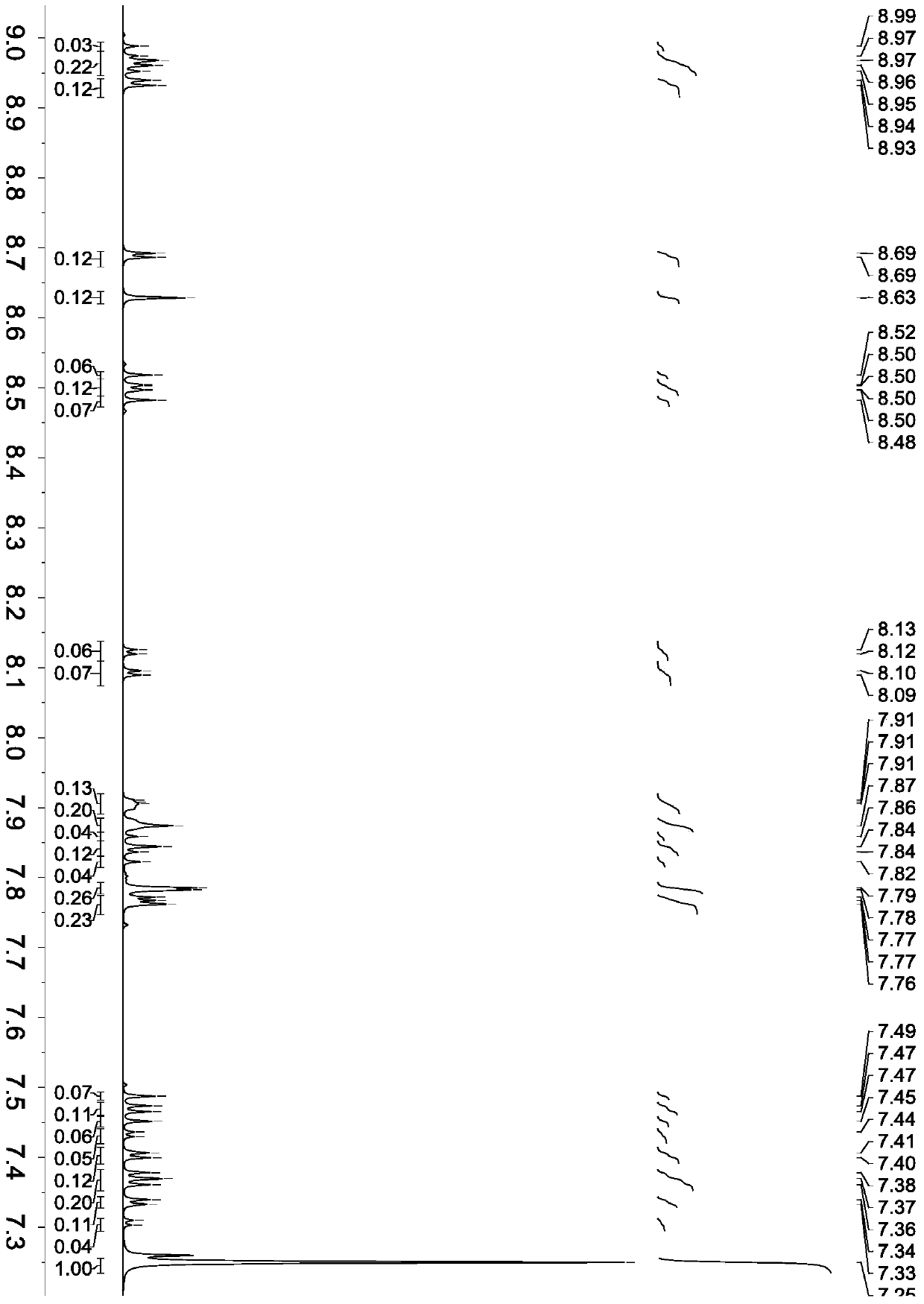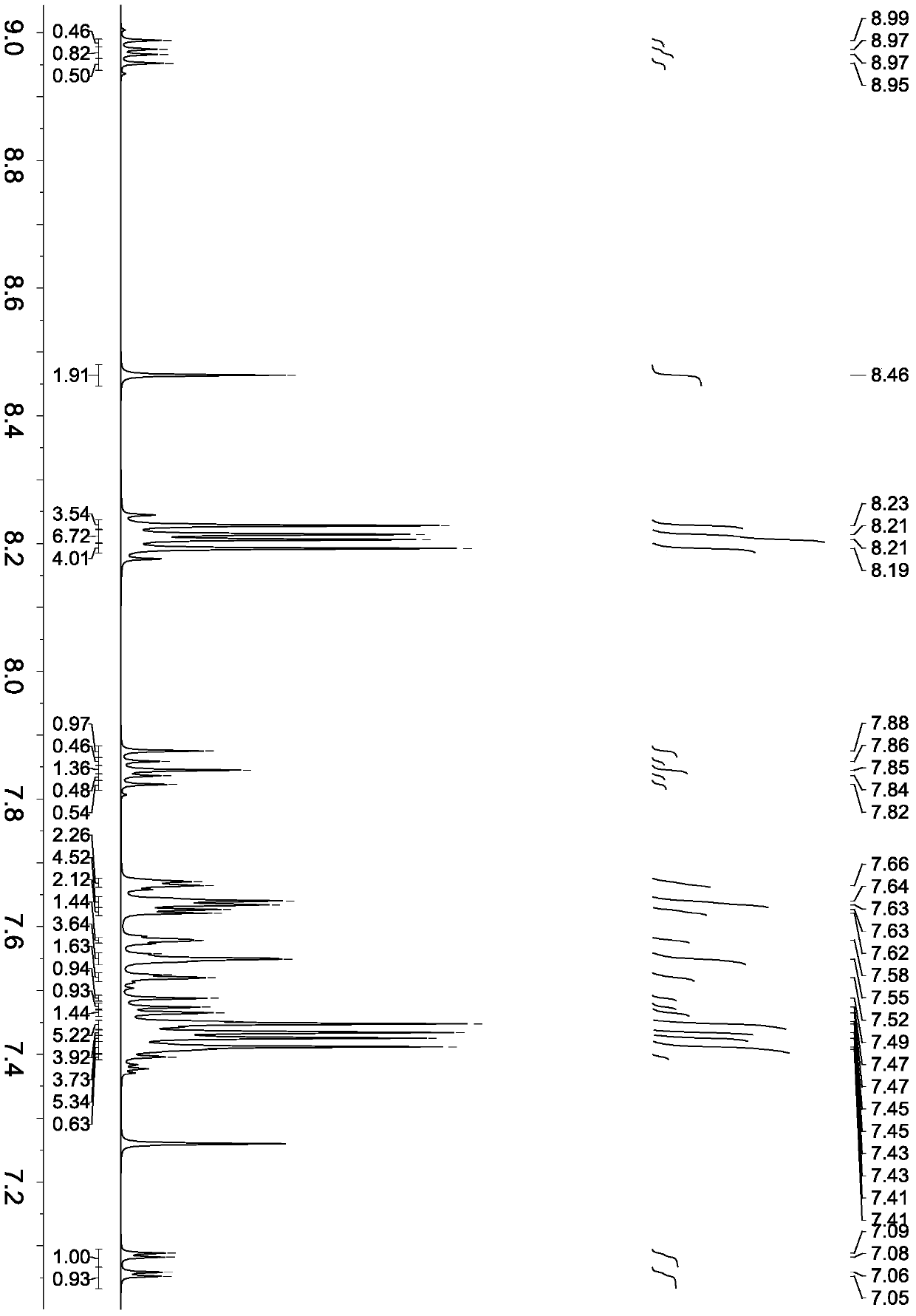A kind of benzophenazine derivative and its application in organic electroluminescence device
A technology of benzophenazine and its derivatives, which is applied in the field of organic electroluminescence, can solve the problems of increasing the complexity of device manufacturing process, reducing the cost of OLED, and unfavorable problems, so as to achieve good electron acceptance ability, improve luminous efficiency, and reduce operating voltage Effect
- Summary
- Abstract
- Description
- Claims
- Application Information
AI Technical Summary
Problems solved by technology
Method used
Image
Examples
Embodiment 1
[0047] The synthesis of embodiment 1 dibromobenzophenazine intermediate
[0048] 1,5,9-Dibromobenzo[a]phenazine and 5,10-dibromobenzo[a]phenazine
[0049]
[0050] Add 3.91 grams of 4-bromo-o-phenylenediamine (molecular weight 186, 0.021mol), 4.96 grams of 4-bromonaphthalene-1,2-dione (molecular weight 236, 0.021mol), ethanol (40 milliliters) in the 250ml there-necked flask, Under the condition of stirring, 0.2 g of concentrated sulfuric acid was added dropwise within 3 minutes, and reacted at 65°C for 4 hours. After the reaction was completed, it was cooled to room temperature, filtered, washed with water, dried, separated by column chromatography, and rinsed with ethyl acetate / petroleum ether to obtain Almost equal amounts of 5,9-dibromobenzo[a]phenazine and 5,10-dibromobenzo[a]phenazine totaled 6.86 g (molecular weight 386), with a total yield of 84.6%.
[0051] 2,3,9-Dibromobenzo[a]phenazine and 3,10-dibromobenzo[a]phenazine
[0052] The synthesis process is the same ...
Embodiment 2
[0054] Synthesis of compound shown in formula (7)
[0055]
[0056] 1000ml three-necked flask, equipped with magnetic stirring, nitrogen protection, add 7.72g of 5,9-dibromobenzo[a]phenazine (molecular weight 386, 0.02mol), naphthalene-2-boronic acid 7.4g (molecular weight 172, 0.043mol) , tetrakis ((triphenylphosphine) palladium 2.3g (molecular weight 1154, 0.002mol), 2M sodium carbonate aqueous solution 100ml, toluene 100ml, ethanol 100ml. After argon replacement, reflux, monitor with thin layer chromatography (TLC) method Reaction, after 4 hours TLC finds that raw material bromide reaction is complete, only product point.Cool down, separate organic layer, evaporate to dryness, column chromatography, ethyl acetate / sherwood oil washing, obtain the compound shown in 8.1g formula (7) , molecular weight 482, yield 86.7%.
[0057] Product MS (m / e): 482, elemental analysis (C 36 h 22 N 2 ): theoretical value C: 89.60%, H: 4.60%, N: 5.81%; measured value C: 89.54%, H: 4.62%,...
Embodiment 3
[0059] Synthesis of compound shown in formula (8)
[0060] The synthesis steps are the same as in Example 2, except that naphthalene-2-boronic acid is changed to naphthalene-1-boronic acid, and other reagents are kept unchanged to obtain the compound represented by formula (8).
[0061] Product MS (m / e): 482, elemental analysis (C 36 h 22 N 2 ): theoretical value C: 89.60%, H: 4.60%, N: 5.81%; measured value C: 89.56%, H: 4.58%, N: 5.86%.
PUM
 Login to View More
Login to View More Abstract
Description
Claims
Application Information
 Login to View More
Login to View More - R&D
- Intellectual Property
- Life Sciences
- Materials
- Tech Scout
- Unparalleled Data Quality
- Higher Quality Content
- 60% Fewer Hallucinations
Browse by: Latest US Patents, China's latest patents, Technical Efficacy Thesaurus, Application Domain, Technology Topic, Popular Technical Reports.
© 2025 PatSnap. All rights reserved.Legal|Privacy policy|Modern Slavery Act Transparency Statement|Sitemap|About US| Contact US: help@patsnap.com



